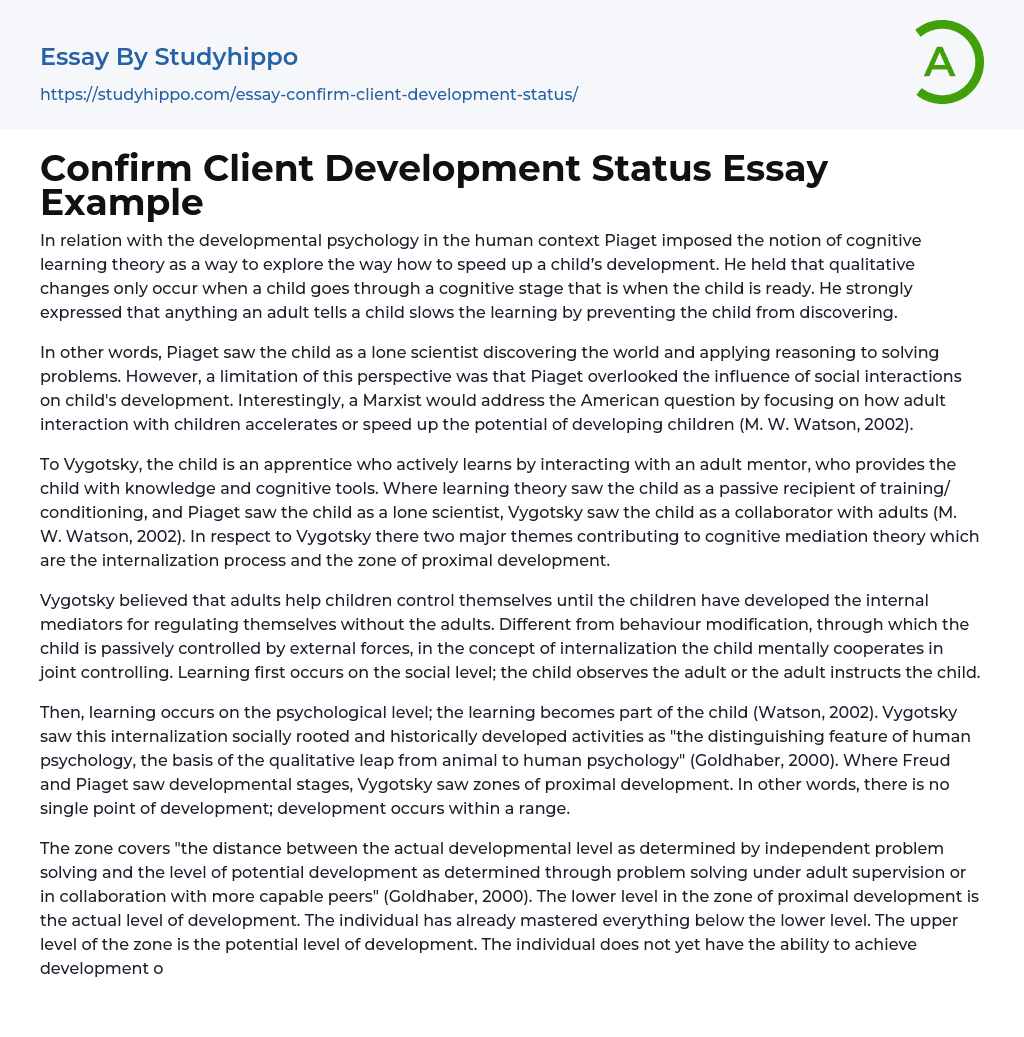In relation with the developmental psychology in the human context Piaget imposed the notion of cognitive learning theory as a way to explore the way how to speed up a child’s development. He held that qualitative changes only occur when a child goes through a cognitive stage that is when the child is ready. He strongly expressed that anything an adult tells a child slows the learning by preventing the child from discovering.
In other words, Piaget saw the child as a lone scientist discovering the world and applying reasoning to solving problems. However, a limitation of this perspective was that Piaget overlooked the influence of social interactions on child's development. Interestingly, a Marxist would address the American question by focusing on how adult interaction with children accelerates or speed up the potential of developing children (M. W. Watson, 200
...2).
To Vygotsky, the child is an apprentice who actively learns by interacting with an adult mentor, who provides the child with knowledge and cognitive tools. Where learning theory saw the child as a passive recipient of training/ conditioning, and Piaget saw the child as a lone scientist, Vygotsky saw the child as a collaborator with adults (M. W. Watson, 2002). In respect to Vygotsky there two major themes contributing to cognitive mediation theory which are the internalization process and the zone of proximal development.
Vygotsky believed that adults help children control themselves until the children have developed the internal mediators for regulating themselves without the adults. Different from behaviour modification, through which the child is passively controlled by external forces, in the concept of internalization the child mentally cooperates in
joint controlling. Learning first occurs on the social level; the child observes the adult or the adult instructs the child.
Then, learning occurs on the psychological level; the learning becomes part of the child (Watson, 2002). Vygotsky saw this internalization socially rooted and historically developed activities as "the distinguishing feature of human psychology, the basis of the qualitative leap from animal to human psychology" (Goldhaber, 2000). Where Freud and Piaget saw developmental stages, Vygotsky saw zones of proximal development. In other words, there is no single point of development; development occurs within a range.
The zone covers "the distance between the actual developmental level as determined by independent problem solving and the level of potential development as determined through problem solving under adult supervision or in collaboration with more capable peers" (Goldhaber, 2000). The lower level in the zone of proximal development is the actual level of development. The individual has already mastered everything below the lower level. The upper level of the zone is the potential level of development. The individual does not yet have the ability to achieve development outside the potential level.
The individual can achieve everything between the actual and potential level of development. Vygotsky's ideas help educators adjust instructions to match the zone of proximal development within a classroom to meet the developmental needs of individual students. Addressing the challenge of applying Vygotsky's ideas in education environments, Watson (2002) says, "A good teacher is someone who can determine the appropriate help to give a student at an appropriate level on a task, with the right amount of examples.
A good teacher must also know when to
withdraw help" to keep challenging the student to progress (p. 199). However, Vygotsky's approach has some problems. Watson says that the zone is a metaphor that is hard to test, and that assessing an individual's dynamically changing zone is an elusive process. In other words, while cognitive-mediation theory can serve as a general guide to development, it lacks the accuracy to serve as a map.
- Academia essays
- Higher Education essays
- Language Learning essays
- Studying Business essays
- Education System essays
- Study essays
- First Day of School essays
- Scholarship essays
- Pedagogy essays
- Curriculum essays
- Coursework essays
- Studying Abroad essays
- Philosophy of Education essays
- Purpose of Education essays
- Brainstorming essays
- Educational Goals essays
- Importance Of College Education essays
- Brown V Board of Education essays
- The Importance Of Higher Education essays
- Online Education Vs Traditional Education essays
- Academic And Career Goals essays
- Academic Integrity essays
- Brown Vs Board Of Education essays
- Distance learning essays
- Technology in Education essays
- Vocabulary essays
- Writing Experience essays
- Importance of Education essays
- Early Childhood Education essays
- Academic Degree essays
- Academic Dishonesty essays
- School Uniform essays
- Academic writing essays
- Cheating essays
- Bachelor's Degree essays
- MBA essays
- College Life essays
- Grade essays
- Diploma essays
- Phonology essays
- Sentence essays
- Filipino Language essays
- Pragmatics essays
- Millennium Development Goals essays
- History Of Education essays
- Graduate School essays
- Middle School essays
- School essays
- Special Education essays
- University essays




